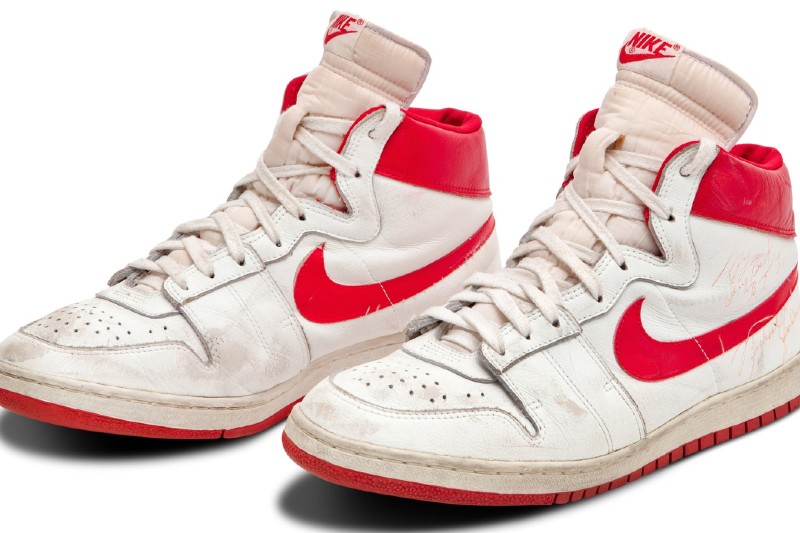
Marketers, designers, and sneakerheads have helped elevate shoe collecting to high art. This past Sunday, one of the industry’s masterpieces sold for upwards of $1.4 million.
White and red leather Nike Air Ships, Michael Jordan’s earliest game-worn professional high-tops to surface at market, sold for $1,472,000 at a luxury sale in Las Vegas, setting a new record price at auction. Featuring Nike’s iconic swoosh, Nick Fiorella, a well-known collector, purchased the kicks. It is the highest sum ever paid for any sports game-worn footwear and smashes last year’s record $615,000 sale for another pair of game-worn Jordan sneakers. Like any icon worth its place in history, these trainers are shrouded in myth and mistruth.
This pair of Air Ships were a gift from Jordan to Denver ball boy ‘TJ’ Lewis following the Bulls vs. Nuggets game on Nov. 1, 1984. This was the same year that Jordan and Nike began a long-running collaboration on a range of shoes and clothes. Nike gave the rookie his own signature line of shoes and clothes, which was pivotal in signing Jordan. This was Nike’s first foray into endorsement, which paved the way for today’s endless player collaborations.
David Falk, the shooting guard’s agent, coined the term “Air Jordan” because Nike shoes had air in the soles, and to describe the air up there in Jordan’s stratosphere. Before Nike designer Peter Moore sat down with a young Jordan to create the Air Jordan 1, a shoe that would become the sneakerhead Holy Grail, Nike supplied Jordan with Air Ships — in red and white and black and red versions.
On Feb. 15, 1985, the NBA submitted a letter to Nike Vice President Rob Strasse stating that the red and black shoe that Jordan was wearing the previous Oct. 18 was against league decorum. NBA policy required each player to wear shoes matching teammates and team colors. Jordan being Jordan, he continued to wear the shoes and to get fined $5,000 for each instance.
Hence, the Air Jordan 1 was deemed to be “banned,” kicking off one of the most successful ad campaigns of all time and ushering in a revolution for the shoe world. Early orders brought in over $55 million for Nike, and, after the brand projected selling 100,000 units, sold between 3 and 4 million pairs in just the first year of the shoes’ release.
Related Guides
While it is generally accepted now that the Air Ship was the real banned sneaker, Jordan has stuck with the apocryphal version of the banned Air Jordans over the last 30 years.
The auctioned white and red leather pre-Air Jordan high-tops also carry a peculiar detail on the heel. In most examples, the back of the shoes show a “Nike Air” decal. On this particular pair, though, they just say “Air.” In very early games, Michael can be seen wearing this unusual model.
In history’s circular shape, it is fitting that the shoes that kicked off an entire footwear revolution should now be the most expensive sold. Resale and sneaker specialist sites that allow collectors to trade “player exclusives” and limited-edition shoes has fueled a global sneaker resale market valued at $6 billion in 2019, and forecast to be worth $30 billion by 2030.
While sneakers were once considered a dirty word in fashion circles, sports-inspired footwear is now a leading luxury category with celebrities sporting exclusive versions on catwalks and red carpets, affirming secondhand sneakers as rivals to fine art.
For history’s sake, you can check out the original Banned ad here:
Read More: A$AP Nast and Lacoste’s Exclusive L001 Lux Sneaker



